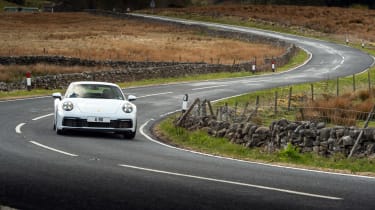Porsche 911 review - ride and handling
Still feels like a proper 911, but only delivers those familiar sensations when you’re driving hard
If stepping inside the 992’s cabin suggests an increased air of maturity next to those of previous 911s, then the driving experience continues this initial observation. While still undoubtedly a 911, it now takes just a little more digging to unearth qualities that were previously much closer to the surface.
This may, at first, be a little disappointing for some 911 diehards. Particularly as the 992 feels just a little less tactile than the 991 it replaced, delivering fewer sensations through seat, steering and pedals, and its petrol particulate filter-muffled exhausts delivering less flat-six fizz through to the cabin. Driven at a moderate pace, everything feels just a little too ‘normal’, as if you’re in a downsized Panamera rather than a 911 – still a level above many cars, but no longer as characteristically ‘911’.
The good news is that as you increase the pace, the shroud does get slowly pulled away. Switch the PDK to manual mode and hang on to lower gears, and the engine feels more enthusiastic, unleashes familiar sounds and has excellent throttle response. Lean harder on the brakes and pedal feel and bite begins to emerge. Give the front tyres more to think about and feedback begins to creep through the steering wheel rim, while bumps and undulations can set the light nose bobbing ever so slightly. And you can get on the power good and early, knowing that if you’re smooth, the rear tyres will simply hook up and launch you down the next straight.
The downside to all this is that given the 911’s performance threshold is now so high, you’ll be travelling at quite some rate by the time your 992 has turned into a 911. Porsche’s own 718 Cayman still demonstrates its abilities and its balance at more accessible speeds, and as the 911 grows ever wider, its smaller counterpart still feels better sized for UK roads. There is, of course, one caveat – the handling balance in low-grip situations is highly entertaining, with Porsche’s typical clarity of control allowing you to augment the 911’s movements with accuracy and confidence at much lower speeds.
More reviews
Group tests
- Mercedes-AMG GT 63 v Porsche 911 Turbo S: all-wheel drive GTs go head-to-head
- Porsche 911 GT3 group test – 996 takes on 997
- Porsche 911 GT3 Manthey Racing v Spartan: £200,000 track toys battle it out
In-depth reviews
- Porsche 911 GT3 (996, 1999-2005) review – the purest GT3 of them all?
- Porsche 911 (992.1, 2018-2024) – the 911 of the digital age
Reviews
As a GT, the 911 is better than ever, but still falls short of being able to morph into a true GT. There’s still plenty of characteristic 911 road roar, but wind and engine noise are well suppressed. And while the ride is quite firm at low speeds, it seems to improve as your velocity increases – as a fast A-road or motorway cruiser, those Panamera-like talents are easy to appreciate.
The manual transmission is, of course, an important additive to the 911’s viscerality, with its sweet shift and an inherently more connected experience that no automatic transmission can offer. The issue is the long gearing, which despite its seven ratios tops out at 85mph in second and 110mph in third, essentially keeping you in the engine’s lower half of the rev range at all times on the road. Long gearing in manual Porsches is quickly turning from a mild inconvenience to a real flaw, and granted it’s due to some particularly unfriendly emissions regulation cycles, it is a problem that needs to be addressed.
With the full rainbow of 911 variants now available, there is another impression that’s been revealed in the 992 and that’s the sheer variability it can display. This is especially true of the curated models, the GTS and T, which both feel like they genuinely add even more diversity to the range. These models can sometimes feel like little more than a trim level, but both have distinct characters that bookend the 911 Carrera experience. The Carrera T, specifically with the manual transmission, seems to hand back control of the 992 to the driver through its tactility. It’s confident and assertive, but also balanced and nuanced, forcing the driver to drive well in order to get the most out of the chassis.
By contrast, the Carrera 4 GTS almost feels somewhere between a GT3 and Turbo, especially when equipped with all-wheel drive. Naturally, there’s monster grip from the all-wheel-drive chassis and scope for some angles if you defeat the stability systems, but it’s the way the GTS transitions from mild to wild that’s so satisfying. In some cars it’s like throwing a switch, but the GTS bleeds one phase into the next. You can flow through to maximum effort or linger in the outer reaches of the performance envelope. That’s what the GTS is really good at. Being seamless. Making the dynamic contrasts and nuances to be had at seven and eight-tenths as absorbing and rewarding as surfing the limit.
In any case, the 911 Carrera still is a stunningly brilliant sports car, but only really shines when it’s specified – whether through a model variant or the options list – in a particular direction.






